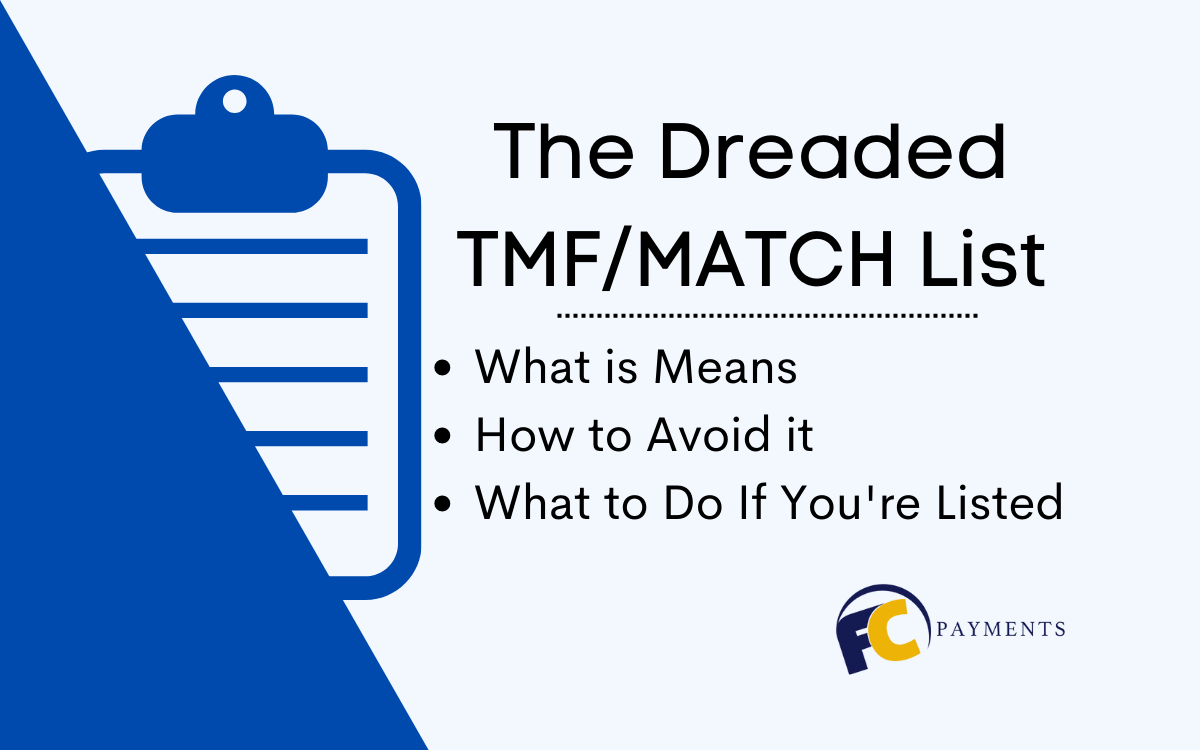
What is a TMF or MATCH List & Why Does It Matter?
TMF (Terminated Merchant File) is a list of merchants who have been terminated by their acquiring bank or payment processor due to fraudulent activities, excessive chargebacks, or violations of the card network’s rules and regulations. These days it’s called the MATCH list as well (Member Alert to Control High-risk).
Think of the TMF as the business the naughty list that banks use to keep track of merchants who have violated too many of their rules and guidelines. If a business is listed on the TMF it could be blacklisted from opening a new merchant account with another acquiring bank or payment processor. This is because banks and payment processors often consult the TMF to assess the risk of doing business with a merchant.
Traditional banks and payment processors usually avoid businesses listed on the TMF because their high-risk operation can result in significant financial losses.

Merchants who are listed in the TMF should work to resolve any outstanding issues with their acquiring bank or payment processor and take steps to improve their business practices to avoid future problems. They may also need to work with a high-risk merchant account provider who specializes in working with businesses that are listed in the TMF.
Common Reasons Merchants Are Listed on the TMF or MATCH List
Merchants will be added to the MATCH list for many reasons, but typically it is because they have engaged in activities that violate the rules and regulations of the card networks. After a while, the merchant will be deemed high risk by their acquiring bank. Here are the most common reasons for this:
Excessive chargebacks: If a merchant has a high number of chargebacks, it could signal the bank that the merchant is providing poor quality products or services.
Fraudulent activities: Merchants who engage in fraudulent activities, such as using stolen credit card information.
Violations of card network rules: Merchants who violate the rules and regulations of the card networks, such as by failing to properly disclose fees or using unauthorized payment methods.
Bankruptcy or insolvency: Merchants who file for bankruptcy or become insolvent or may be unable to fulfill their financial obligations to their acquiring bank or payment processor.
Data Compromise: If the merchant access customer account data without that customer’s authorization.
Security Breaches: If a customer’s payment information is stolen from the merchant’s database and used to make fraudulent transactions elsewhere.
How Can You Get Off the MATCH List?
Getting off the MATCH list is difficult but not impossible.
Step 1: Contact the acquiring bank or payment processor and ask why the business was added to the TMF and MATCH list.
Step 2: Create a strategy to resolve the issues and to ensure that there is no other violations that may be occurring.
Step 3: Begin working with a high risk merchant account payment processor to continue taking payment and to begin creating a history of compliance.
Step 4: Contac the acuqring bank and request a review based on new changes.
Ultimately, it’s important to take action to avoid continued violations and to ensure payments are processed without interuption. Here are some of the most common strqategies used by busineses to get off the TMF or MATCH list.
Resolving outstanding issues: Work to resolve any outstanding issues with the acquiring bank or payment processor, such as paying off any outstanding debts or resolving chargebacks.
Implementing fraud prevention measures: Iimplement fraud prevention measures like secure payment processing systems to prevent future fraudulent activities.
Improving customer service: Focus on providing high-quality products and services and improve customer service to reduce the likelihood of chargebacks. Provide refunds directly to customers.
Working with a high-risk merchant account provider: Merchants who are unable to obtain a merchant account from a traditional acquiring bank or payment processor may need to work with a high-risk merchant account provider who specializes in working with businesses that are on the MATCH list.
Proactive measures are the best means to address the issues that lead to being listed on the TMF or MATCH list.
I am passionate about delivering results and helping my clients succeed. With my expertise in SEO, branding, and marketing, I lead the agency’s efforts to create and implement effective strategies that drive business growth. Our all-inclusive approach sets us apart from other digital media companies and ensures that our clients receive the full range of services they need for online success. If you can think of it, we can build it!
Zulu Shack Creative team members thrive on momentum. Like Zulu warriors, we strive to spearhead your idea with speed and quality.
When I’m not helping my team implement new digital marketing strategies, I enjoy playing music, hosting poker nights, reading Stephen King novels, and spending time with my wife and baby daughter.
No Comments
Sorry, the comment form is closed at this time.



